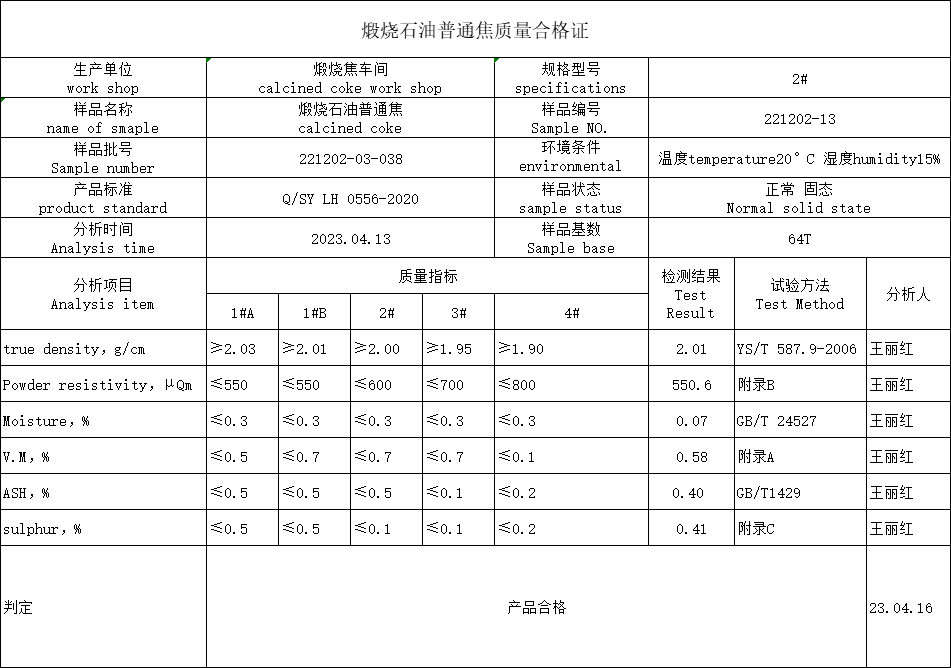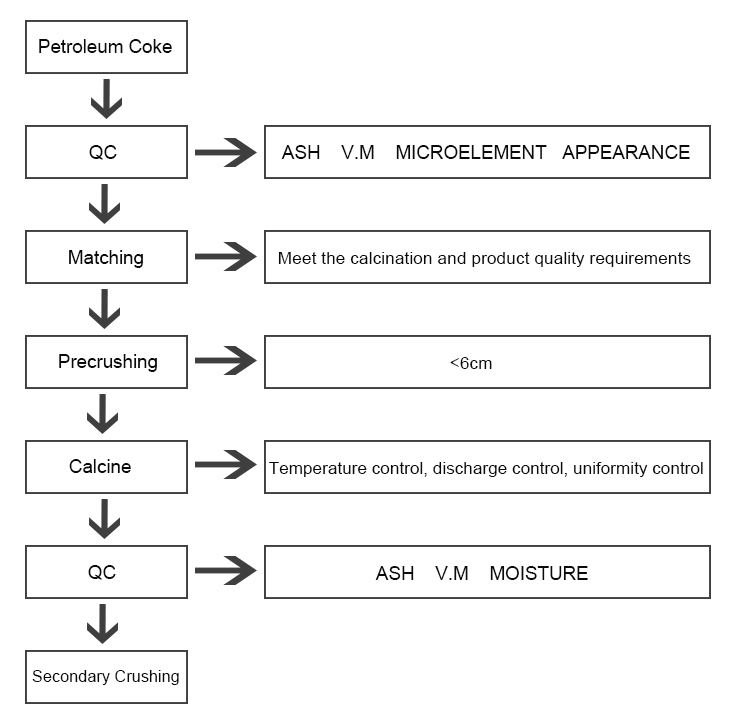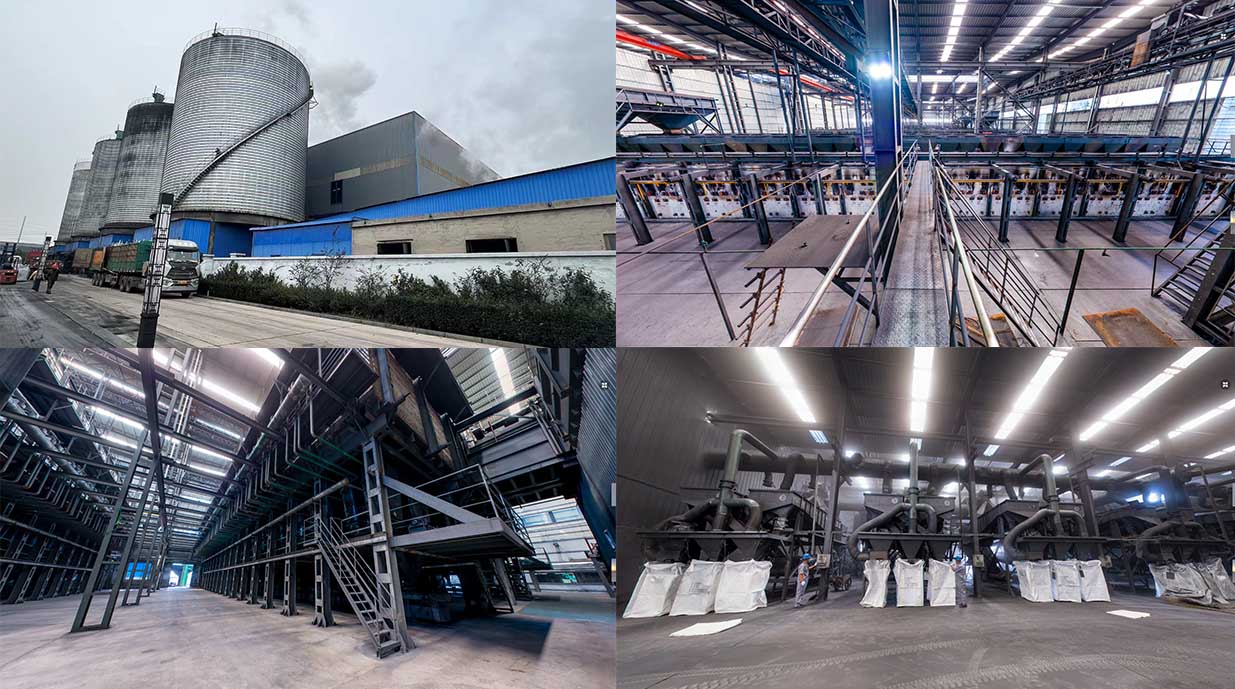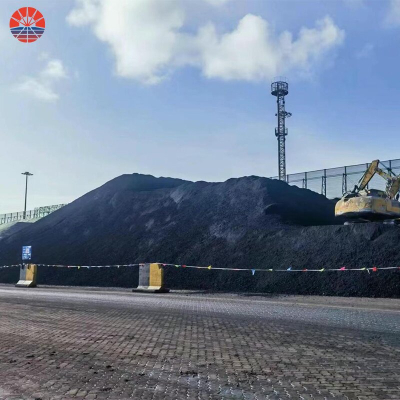1.0% Sulphur Calcined Coke
Calcined coke plays a crucial role in the production of graphite electrodes, which are essential components used in electric arc furnaces for the smelting of steel and other metals. The benefits of using calcined coke in the production of graphite electrodes include:
High purity: Calcined coke is manufactured with low impurity levels, ensuring that the graphite electrodes produced are of high purity. Impurities can negatively impact the performance of the electrodes during the smelting process, leading to reduced efficiency and potentially compromising the quality of the final product.
Superior electrical conductivity: Calcined coke has a high carbon content, which translates to excellent electrical conductivity. This is a critical property for graphite electrodes, as they need to efficiently conduct electrical energy to generate the high temperatures required for metal smelting in electric arc furnaces.
High mechanical strength: Graphite electrodes must withstand significant mechanical stresses during the steelmaking process. Calcined coke provides the necessary mechanical strength and structural integrity to endure the harsh conditions in the electric arc furnace without fracturing or crumbling.
Low thermal expansion: Calcined coke-based graphite electrodes have a relatively low coefficient of thermal expansion. This characteristic ensures that the electrodes can maintain their shape and dimensions even under rapid and extreme temperature changes during the smelting process.
High resistance to oxidation: The production of steel in electric arc furnaces involves exposure to oxygen and other oxidizing agents. Calcined coke-based graphite electrodes exhibit high resistance to oxidation, preventing rapid consumption of the electrode material and prolonging their lifespan.
Consistency in quality: The strict control of calcined coke production processes ensures uniform properties and high consistency in the quality of graphite electrodes. This predictability is essential for steel manufacturers, as it allows them to optimize their operations and maintain stable smelting conditions.
Reduced environmental impact: As with its use in aluminum production, the utilization of calcined coke in graphite electrode production allows for the recycling of petroleum coke, a byproduct of oil refining. This recycling process contributes to environmental sustainability.
Energy efficiency: The high electrical conductivity and low thermal expansion of graphite electrodes produced with calcined coke result in improved energy efficiency during the steelmaking process. This efficiency leads to reduced energy consumption and lower production costs.
Extended electrode life: Due to its high-quality properties, graphite electrodes made from calcined coke can have a longer service life. Longer-lasting electrodes mean fewer electrode changes, reduced downtime, and increased productivity for steel manufacturers.
In conclusion, using calcined coke in the production of graphite electrodes offers numerous benefits, including high purity, excellent electrical conductivity, mechanical strength, low thermal expansion, oxidation resistance, and energy efficiency. These advantages contribute to the overall efficiency, productivity, and cost-effectiveness of the steelmaking process using electric arc furnaces.
Advantage to using Calcined Petroleum Coke in graphite electrode
Here's the correct information regarding the usage of calcined coke and needle coke in the production of graphite electrodes:
Calcined Coke: Calcined coke, as discussed earlier, is mainly used in the production of aluminum and other applications. It is not a primary material for making graphite electrodes.
Needle Coke: Needle coke is the primary raw material used in the production of graphite electrodes. It is a premium-grade petroleum coke with a unique structure that contains a high concentration of graphite. This structure provides the necessary mechanical strength, electrical conductivity, and low coefficient of thermal expansion required for high-performance graphite electrodes.
The manufacturing process of graphite electrodes involves the following steps:
a. Preparation of Green Mix: The green mix is a blend of needle coke, coal tar pitch, and various additives. The proportion of needle coke in the mix significantly influences the quality and performance of the final graphite electrode.
b. Forming: The green mix is extruded or molded into the desired shape and size of the graphite electrode.
c. Baking: The molded green electrodes are then baked at extremely high temperatures (around 2,000 to 3,000 degrees Celsius) in a controlled environment. This process is known as carbonization or graphitization, during which the green mix is transformed into a graphite-like structure.
d. Impregnation: After baking, the graphite electrodes may undergo impregnation with pitch to enhance their density and mechanical strength further.
e. Graphitization: The baked electrodes are then graphitized at even higher temperatures, which increases their electrical conductivity and improves their mechanical properties.
f. Machining: Finally, the graphite electrodes are machined and coated to meet specific customer requirements and quality standards.
In summary, while calcined coke has essential applications in various industries, it is not used in the production of graphite electrodes. Instead, needle coke, a specialized form of petroleum coke, is the primary material used for manufacturing high-quality graphite electrodes used in electric arc furnaces for steel and other metal production processes.











